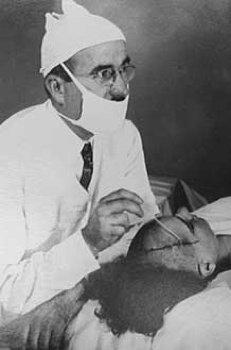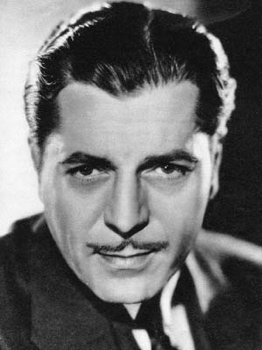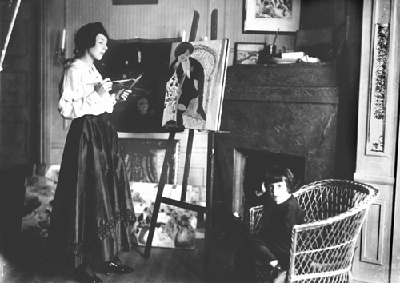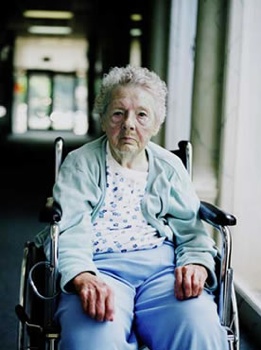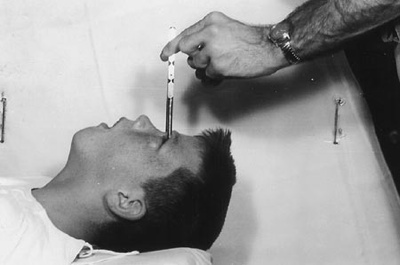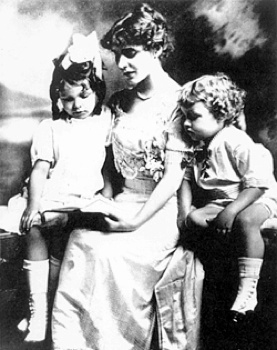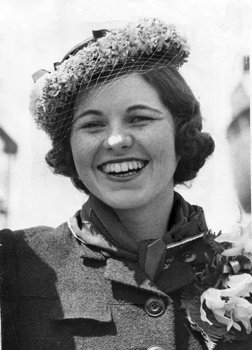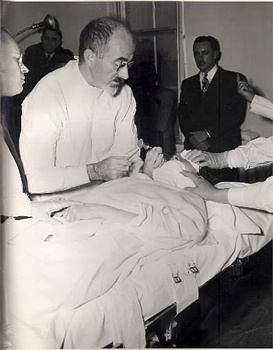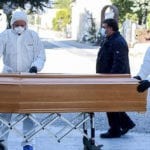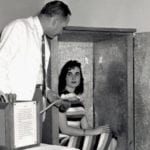Note: I know many will wonder why Frances Farmer in not included in this list. There is no proof that Frances Farmer ever had a lobotomy and the author who initially alleged this admitted in a court proceeding that he had made it up.
Notable Because: First prefrontal lobotomy procedure in the United States The first prefrontal lobotomy in the United States was performed in 1936 on 63 year old Alice Hood Hammatt by Dr. Walter Freeman and Dr. James Watts. The doctors started the surgery by making incisions 3 centimeters in length and then using an auger (drill) they made holes in the skull over the left and right frontal lobes. They then inserted a leucotome (a narrow shaft) 4 centimeters straight down through the hole on the left side into the exposed surface of the brain. The entire operation lasted about an hour. Some months after her surgery, Hammatt suffered a convulsion likely related to her surgery. However she continued to live with reduced anxiety and stayed out of mental hospitals. Her husband thought she behaved more normally than ever before after the surgery and called the next five years the happiest of her life. Alice Hammatt contracted pneumonia and died at age 68. Interesting Fact: Freeman and Watts closely followed the same procedure as Egas Moniz and Almeida Lima who performed the same surgery a year earlier which they called “leucotomy”. Moniz was a Portuguese neurosurgeon and the first Portuguese to receive a Nobel Prize for his discovery of the therapeutic value of leucotomy in certain psychoses.
Notable Because: American Actor Warner Baxter is best known for his role as The Cisco Kid in Old Arizona, for which he won the Academy Award for Best Actor. By 1936, Baxter was the highest paid actor in Hollywood earning $284,000. Baxter made over a hundred films between 1914 and 1950. Later in life Baxter suffered from arthritis. During this time many people were lobotomized for constant pain, such as chronic or severe backaches and agonizing headaches. Baxter’s arthritis became so painful he decided to have an ill-advised lobotomy to ease the pain. Baxter died shortly after the surgery of pneumonia. Interesting Fact: during the prefrontal lobotomy heyday in the 1940s and ’50s, it was performed on more than 40,000 patients in the United States, and on around 10,000 in Western Europe
Notable Because: Modernist painter Sigrid Hjertén is considered a major figure in Swedish modernism and was married to a well know expressionist painter Isaac Grünewald. Hjertén and Grünewald regularly exhibited together at home and abroad and are often recognized as being responsible for introducing modernism to Sweden. Hjertén suffered from lifelong mental health problems that resulted in her being hospitalized for extended periods in the 1930s. An increasing tension can be seen in her art and reaches its height before the disease forces her to quit painting. In 1937 when she was hospitalized permanently, Grünewald divorced her and married his mistress. In 1946 Grünewald and his second wife were killed in an airplane crash. Hjertén died two years later after a botched lobotomy. Sigrid Hjerén’s total production amounted to slightly more than 500 paintings, together with sketches, water-colors and drawings. Interesting Fact: Scandinavian hospitals lobotomized 2.5 times as many people per capita as hospitals in the United States. Sweden lobotomized at least 4,500 people between 1944 and 1966. A large majority of these surgeries were performed on women.
Notable Because: Internationally recognized singer Alys Robi (real name Alice Robitaille) was Born in Quebec City and displayed talent for singing and acting at a very young age. She first performed on-stage at the Capitol Theater at age 7. In 1948, at age 25 she was injured in a car accident and entered a period of depression. After a failed romance she suffered a mental breakdown and was interned for several years in a Quebec City asylum. She was subjected to a lobotomy against her will but later credited the operation with her recovery and understood that she was one of the rare success stories. In 1952, she was released and reentered stage but her efforts were impeded by taboos of mental illness. Robi never regained the same level of popularity. However in the early 1990s Robi returned into the public eye after the massive success she had with a song written for her by Alain Morisod. The song is called “Laissez-moi encore chanter” which you can hear in the clip above. Interesting Fact: Robitaille has published two autobiographies: Ma Carrière, ma vie (“My career, my life) and Long Cri dans la nuit: Cinq Années à l’Asile (“Long cry in the night: five years in the asylum)
Notable Because: First transorbital or “ice pick” lobotomy The first transorbital (ice pick) lobotomy was performed in 1946, also by Dr. Walter Freeman. Ionesco was a 29 year-old housewife and mother who was described as violently suicidal. In His Washington D.C. office, Freeman rendered Ionesco unconscious through electroshock. He then inserted an ice pick above her eyeball, banged it through her eye socket into her brain and then swirled it around in a sort of eggbeater motion to scramble the neural connections. The family considered the operation a success and a blessed relief. She lost some memory function but was relatively intact and led a fairly normal life. Interesting Fact: Ionesco’s daughter is quoted saying “It’s a hard decision to make, but inevitably life is just full of decisions like that… For me it was a good thing. I think for mama it was a good thing. And I think the lobotomy he did on her was a very good thing. Certainly the electroshock therapy was. Of course now they have medicine for this, so it’s all a moot point. But they had nothing back then. That’s the thing, people who are looking at it don’t understand, they didn’t have anything else and nobody was coming up with anything.”
Notable Because: Received Lobotomy at 12 years old In 1960 Howard Dully was brought in for the procedure because his stepmother described him as “unbelievably defiant,” saying among other things: He objects to going to bed and does a good deal of daydreaming. After Howard’s stepmother visited with Dr. Freeman, he suggested that the family should consider the possibility of changing Howard’s personality by means of transorbital lobotomy.” Howard’s stepmother convinced her husband (Howard’s Father) that is was the best thing for his son and then gave the doctors his approval. Dully took decades to recover from the surgery; he was institutionalized, incarcerated, and was eventually homeless and an alcoholic. Eventually Dully sobered up and received a college degree and became a California state certified instructor for a school bus company in San Jose, California. Interesting Fact: When Dully was in his 50s he embarked on a two year journey to uncover what happened to him as a child. He spoke with his family and his relatives and other lobotomy patients of Dr. Freeman and gained access to Freeman’s archives. Dully was one of the youngest patients to receive an “ice pick” lobotomy and the first patient ever to obtain a picture of his own lobotomy.
Notable Because: Sister of Tennessee Williams Rose Isabel Williams was born, two years before her brother, Thomas (Tennessee). The two grew up together and became as close as twins. At 18 Rose’s relationships became inconstant and she began to feel unloved. Her behavior had become so erratic that her mother decided to send her away to school in Vicksburg. Later she was committed to a State Hospital and diagnosed as a paranoid schizophrenic. In 1943 after six years of hopeless treatment, including shock therapy, Rose was given a bilateral prefrontal lobotomy that was sanctioned by her mother. After the surgery Rose had lost much of her personality which caused Tennessee intense remorse and guilt for not being able to prevent the surgery from happening and for some time harbored ill feelings toward his mother Edwina for allowing the surgery to happen. Rose provided Tennessee Williams inspiration for his plays, Suddenly, Last Summer and The Glass Menagerie. Interesting Fact: When Tennessee Williams died in 1983 he willed most of his estate to the University of the South in Sewanee, Tenn., with the bulk of it to remain in trust for his sister during her lifetime. When Rose Williams died in 1996 the University of the South announced that they would receive $7 million. The photo above shows Edwina Dakin Williams reading to her children Rose and Tom (the future “Tennessee”).
Notable Because: Famous Violinist Josef Hassid (Józef Chasyd) was born in Poland to a Jewish family and is considered by many as one of the greatest violinist of our time. When Hassid lost his mother as a boy he started showing a quite timid and reclusive temperament. In 1938 he moved to Britain with his father and in 1940 made a magnificent first appearance in London at the age of 16. While performing what is considered one of the most technically complicated pieces of music ever written for violin.(Concerto in D major, Op. 35 by Pyotr Ilyich Tchaikovsky) he had a memory lapse. Then in 1941 he experienced deep depression and suffered a nervous breakdown. He was then committed to St Andrew’s Hospital in Northampton where he underwent insulin coma therapy and electroconvulsive therapy. After a short period spent with his father out of the clinic he was eventually diagnosed with an acute case of schizophrenia and committed again, this time to Long Grove Hospital mental asylum in Epsom, Surrey, which had a wing for Polish civilians. There he remained until his death at 26 caused by an unsuccessful lobotomy. Interesting Fact: Hassid left us with only 9 recordings. You can hear his Meditation de Thais by Massenet in the clip above.
Notable Because: Sister of John F. Kennedy Rosemary was said to have been considered retarded by members of her family but that assessment has been widely disputed by subsequent analysts. Some concluded that Rosemary may not have been as brilliant as other members of her family but she was a fully functioning person, kept a diary and had an active social life. Rosemary was reportedly subject to violent mood swings and a stormy personality however some observers have since attributed this behavior to her difficulties in keeping up with her active siblings. In 1941, when Rosemary was 23, her father Joseph Kennedy was told by her doctors that a new procedure would help calm her mood swings that the family found difficult to handle at home. Her father gave permission for the prefrontal lobotomy to be performed by Walter Freeman and James Watts. After the surgery Rosemary was reduced to an infantile mentality that left her incontinent and staring blankly at walls for hours. Her verbal skills were reduced to unintelligible babble. In 1949, Rosemary moved to an institution and was visited on regular occasions by her sister Eunice Kennedy Shriver who became the founder of the Special Olympics. Interesting Fact: During the surgery Rosemary had a mild tranquilizer but was awake. Dr. Freeman asked her to recite the Lord’s Prayer or sing “God Bless America” or count backwards. An estimate on how far to cut was based on how she responded. When she became incoherent, they stopped. When Rosemary died in 2005 at age 86 she was the fifth of the Kennedy children to die but the first to die from natural causes.
Notable Because: Last Lobotomy performed by Dr. Walter Freeman I thought it only fitting to place Dr. Freeman’s last lobotomy in the number one spot. In 1967, Freeman received a visit from Helen Mortensen who was one of his first 10 trans-orbital patients in 1946. She suffered a relapse of her psychiatric symptoms in 1956 and Freeman gave her a second operation. After several more years of working productively, Mortensen wanted a third lobotomy. Freeman did the surgery and severed a blood vessel in Mortensen’s brain. Three days later, Mortensen died. The hospital then revoked Freeman’s surgical privileges and he retired soon after. Interesting Fact: Walter Freeman performed about 3,500 lobotomies in 23 states during his career of which 2,500 were his ice-pick procedure. Freeman died from cancer on May 31, 1972 at the age of 76. You can watch a short documentary of Dr. Freeman here.
